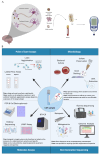Advancements in Cerebrospinal Fluid Biosensors: Bridging the Gap from Early Diagnosis to the Detection of Rare Diseases
- PMID: 38894085
- PMCID: PMC11174891
- DOI: 10.3390/s24113294
Advancements in Cerebrospinal Fluid Biosensors: Bridging the Gap from Early Diagnosis to the Detection of Rare Diseases
Abstract
Cerebrospinal fluid (CSF) is a body fluid that can be used for the diagnosis of various diseases. However, CSF collection requires an invasive and painful procedure called a lumbar puncture (LP). This procedure is applied to any patient with a known risk of central nervous system (CNS) damage or neurodegenerative disease, regardless of their age range. Hence, this can be a very painful procedure, especially in infants and elderly patients. On the other hand, the detection of disease biomarkers in CSF makes diagnoses as accurate as possible. This review aims to explore novel electrochemical biosensing platforms that have impacted biomedical science. Biosensors have emerged as techniques to accelerate the detection of known biomarkers in body fluids such as CSF. Biosensors can be designed and modified in various ways and shapes according to their ultimate applications to detect and quantify biomarkers of interest. This process can also significantly influence the detection and diagnosis of CSF. Hence, it is important to understand the role of this technology in the rapidly progressing field of biomedical science.
Keywords: CSF; biosensing; minimally invasive; smart sensors.
Conflict of interest statement
The authors declare no conflicts of interest.
Figures



Similar articles
-
CSF biomarkers in neurodegenerative diseases.Clin Chem Lab Med. 2011 Mar;49(3):345-52. doi: 10.1515/CCLM.2011.082. Epub 2011 Feb 9. Clin Chem Lab Med. 2011. PMID: 21303297 Review.
-
Electrochemical Biosensors for the Detection of Exosomal microRNA Biomarkers for Early Diagnosis of Neurodegenerative Diseases.Anal Chem. 2025 Mar 18;97(10):5355-5371. doi: 10.1021/acs.analchem.4c02619. Epub 2025 Mar 9. Anal Chem. 2025. PMID: 40057850 Free PMC article. Review.
-
Polymer-Based Electrochemical Sensors for the Diagnosis of Neurodegenerative Diseases.Cell Mol Neurobiol. 2025 May 26;45(1):52. doi: 10.1007/s10571-025-01570-0. Cell Mol Neurobiol. 2025. PMID: 40418370 Free PMC article. Review.
-
Proteomic investigations of the ventriculo-lumbar gradient in human CSF.J Neurosci Methods. 2010 Aug 30;191(2):244-8. doi: 10.1016/j.jneumeth.2010.06.017. Epub 2010 Jun 25. J Neurosci Methods. 2010. PMID: 20599557
-
[Strategies for cerebrospinal fluid analysis - Integrated results report].Nervenarzt. 2016 Dec;87(12):1271-1275. doi: 10.1007/s00115-016-0232-8. Nervenarzt. 2016. PMID: 27785524 Review. German.
Cited by
-
Transformative biomedical devices to overcome biomatrix effects.Biosens Bioelectron. 2025 Jul 1;279:117373. doi: 10.1016/j.bios.2025.117373. Epub 2025 Mar 12. Biosens Bioelectron. 2025. PMID: 40120290 Review.
References
-
- Vernau W., Vernau K.A., Sue Bailey C. Cerebrospinal Fluid. Clin. Biochem. Domest. Anim. 2008:769–819. doi: 10.1016/B978-0-12-370491-7.00026-X. - DOI
-
- Arribas M. The history of cerebrospinal fluid: From classical antiquity to the late modern period. Neurosci. Hist. 2017;5:105–113.
Publication types
MeSH terms
Substances
LinkOut - more resources
Full Text Sources
Miscellaneous

